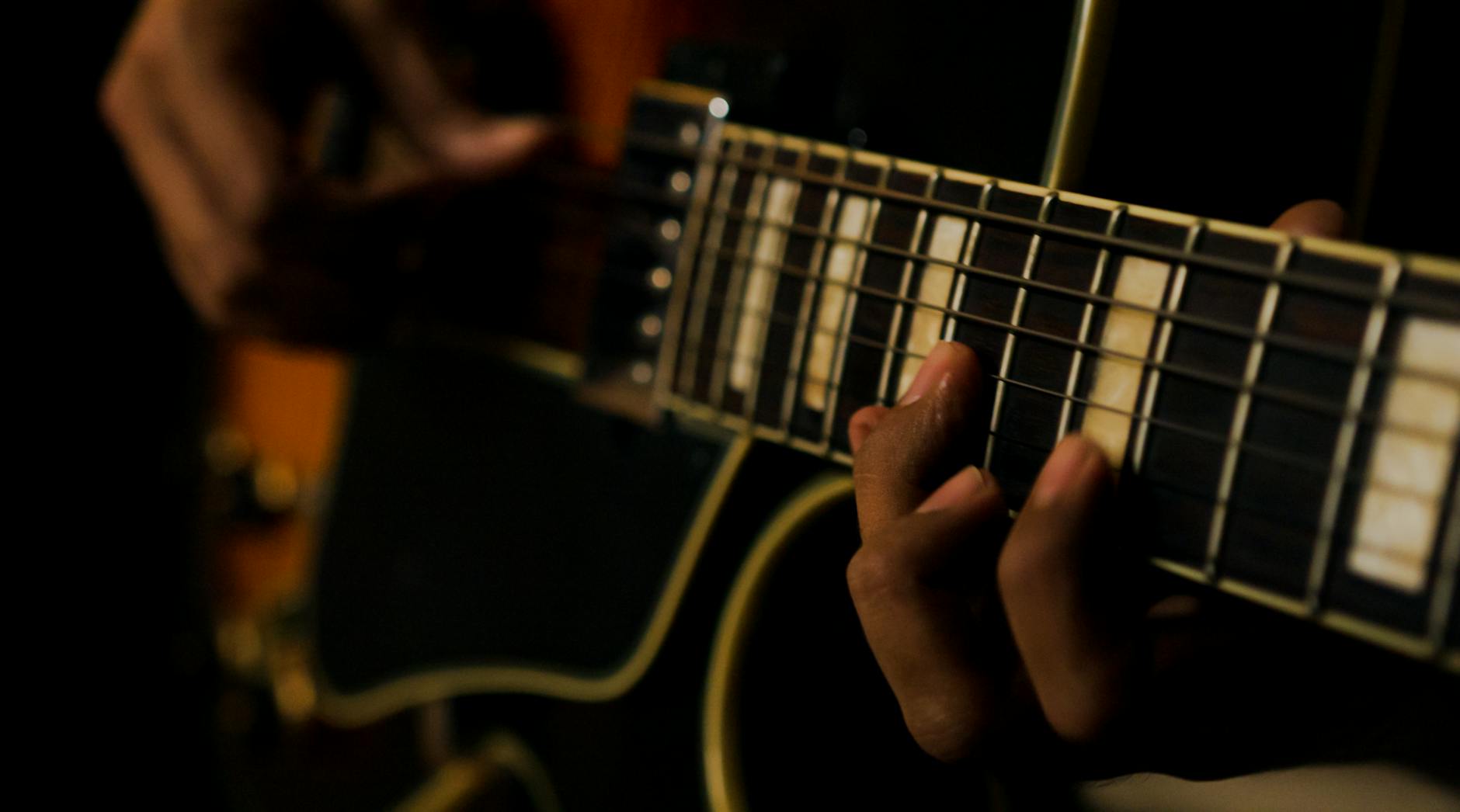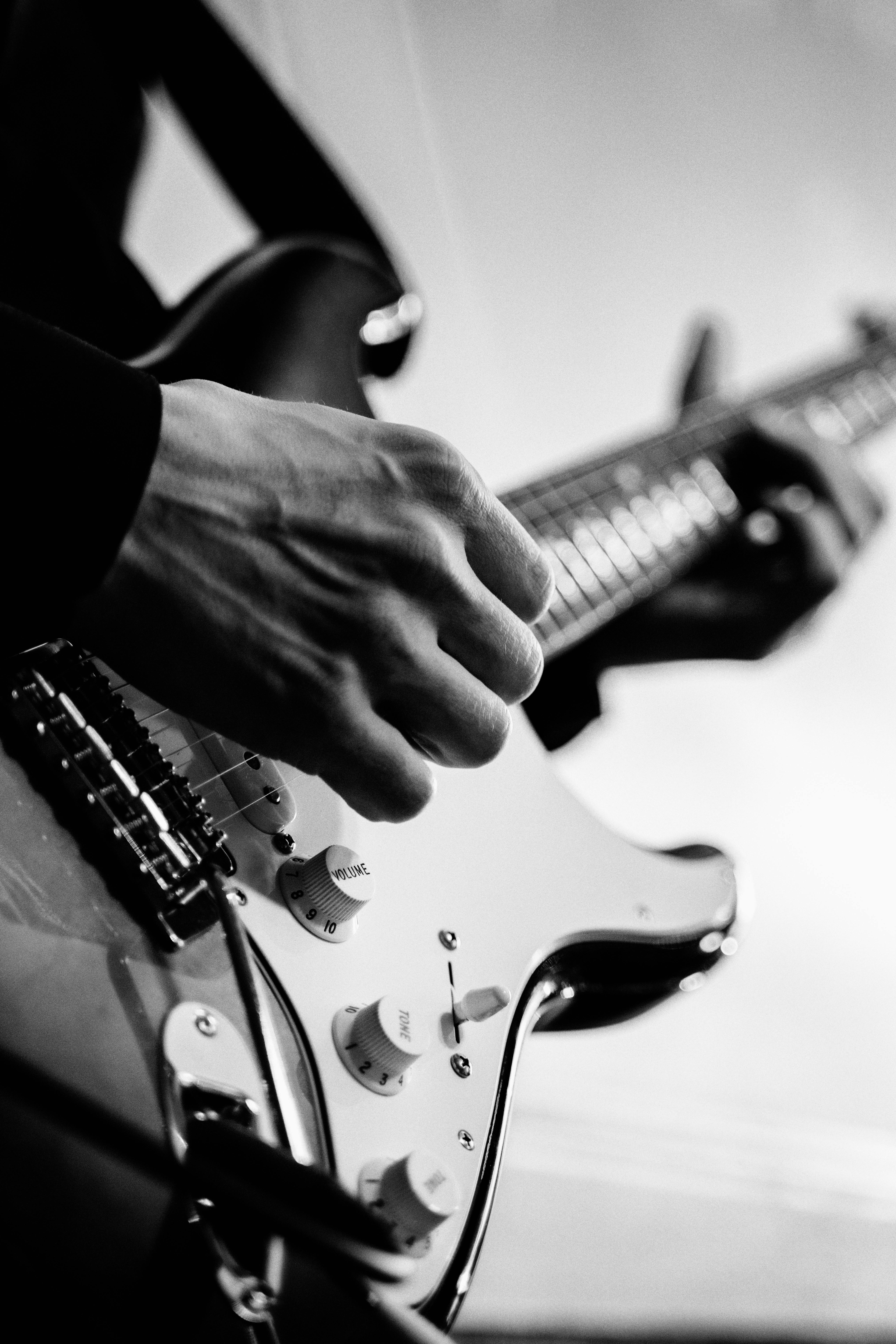
Emotion and creativity are in the spotlight here, turning every note into a story. Whether you’re just starting or looking to add depth to your solos, learning how to connect with your music on a much deeper level is where it’s at.
How to play expressive guitar solos for beginners? Is it all about showing off and cramming in a million notes? Sometimes, but most often it’s about saying something that words can’t.
Using simple techniques like vibrato, bending, or even intentional pauses, you can create a sound that’s uniquely yours, and is what brings a song to life.
Ready to turn your ideas into something unforgettable?

An expressive solo is like telling a story, one that doesn’t need words because the notes say it all. It’s when every bend, every pause, or every soft note makes someone listen a little harder.
At its core, it’s about emotion. You’re not simply playing notes; you’re pouring yourself into the music. To make your solos emotional, focus on two key factors:
The beauty of guitar solos is how universally they connect. Sure, shredders can impress with speed, but the notes that tug at your heart? That’s an entirely different ball game.
Check out these beginner tips to make your solos sing louder than words. For more help, you might enjoy our guide for nailing rock guitar solos, packed with essential techniques you can use right away.

Photo by Billy Lopez
A good question to ask is “what sticks with people after the solo is over?”
Famous guitarists like David Gilmour (Pink Floyd’s “Another Brick in the Wall, Part 2”) or Don Felder and Joe Walsh (Eagle’s “Hotel California”) are masters of this. They’ve created solos that live rent-free in your head because of melodic brilliance.
Here’s a step-by-step tutorial for the solo by Nikola Gugoski:
Here’s where speed takes a backseat. Instead of reaching for every note available on the fretboard, try this:
Even as you focus on melody, keep practicing techniques like vibrato and bending to make those melodies sing. Not sure how to start? Check out Rock Guitar Basic Techniques Every Beginner Should Know for some essential tips to level up your playing.
Let’s be real: blazing fast arpeggios and intricate sweeps are cool, but they don’t connect emotionally, at least not for long, especially if that’s all you have.
For a beginner like you, focusing on expression instead of technical wizardry is a game-changer. Why? Because people remember how a solo made them feel.
So, skip the temptation to show off and instead lean into making your guitar “talk.” Not only will this help connect with your listeners, but it also builds a foundation of creativity for you as a guitarist.
For more inspiration, dive into Finding Your Musical Identity Through Diverse Influences to discover your unique style.
Playing an expressive guitar solo isn’t just about hitting the right notes, it’s about making those notes mean something.
It’s the difference between simply reciting a sentence and delivering it with passion, like an actor bringing a script to life. Have you ever seen really bad actors who sound like robots? You instinctively feel like there’s something off. A great actor, or in this case guitarist, can make you believe they’re the “king of the world!”
Below, we’ll explore the essential techniques every beginner should focus on to add personality and emotion to their solos.

Photo by Clam Lo
Vibrato is like the seasoning of your guitar solo, it takes a plain note and makes it flavorful. By slightly oscillating the pitch of a note, you’ll give those listening…goosebumps the size of a lead singer’s hair back in the 80s.
While advanced guitarists blend vibrato into their unique styles, beginners can find their groove with a few easy exercises.
Here are a couple of vibrato styles to try:
Beginner Exercise: Hold a single note, such as the 7th fret on the G string. Gently rock your finger back and forth on the string to develop control.
Play it slow at first, then gradually speed it up. With regular practice, you’ll start hearing your unique touch emerge.
Want to discover how vibrato contributes to your guitar’s overall sound? Read our guide;
Few techniques mimic the human voice as beautifully as bending and sliding. Imagine the way a singer glides between notes or holds a strong high note, it’s the same effect we’re aiming for here.
These movements add a soulful and vocal quality to your solos, making them more relatable and expressive.
To nail bending:
Practice this daily and it will eventually become muscle memory.
Sliding is just as expressive. Play the 4th fret (low E string), and without lifting your finger, slide to the 7th fret. The smooth transition gives your notes a polished, fluid soul. Try this separately on every string.
For more tips on bending and sliding, visit Rock Guitar Lessons For Beginners.
Sometimes less really is more. Silence in a solo is like taking a pause in conversation, it allows your listener to absorb what’s already been said and anticipate what’s next.
No need to play a million notes a second. Unless you’re Yngwie Malmsteen, leave some breathing room.
To practice this, try a “play and pause” technique. For example:
The magic of leaving space is that it builds tension and keeps your solos fresh every time you pick up the guitar.
Dynamics are what turn a solo into an emotional rollercoaster.
Experimenting with volume and intensity can elevate your solos, from soft and gentle whispers to raw, screaming highs.
Here are some exercises to explore dynamics:
Think about your solo like telling a story: start slow and quiet, build to a peak, then bring it back down for a satisfying conclusion.
Curious about how dynamics shape your playing style? Check out this post for more inspiration
Keep in mind that the journey of expressive playing is unique to you. The more you practice these techniques, the sooner you’ll find your voice, and your solos will truly sing.
Have you ever heard a guitar solo that made you feel like the guitarist was speaking directly to your soul?
That’s the magic of phrasing. It’s not just what you play, it’s how you play it. For beginners, learning to add phrasing into your guitar solos is one of the fastest ways to turn ordinary notes into something extraordinary.

Photo by Khoa Võ
Imagine your guitar solo as a lively back-and-forth conversation. Just like we pause, emphasize, or even raise our voice when we speak, solos become engaging when they mimic these natural dynamics.
Great phrasing isn’t about complexity; it’s about expression.
Here’s how you can apply this mindset to your playing:
Next time you jam, think less about scales and more about what your guitar wants to say. This conversational style will help you connect in a unique way with every listener.
Curious about how guitar phrasing shapes your overall style? Check out Beginner Rock Guitar: Everything You Need to Know.
This is where things get emotional. A great solo takes you on a journey, a thrilling rollercoaster of tension and release.
The trick is knowing how to build suspense and then give your audience the payoff they didn’t even know they were waiting for. Think of those moments in movies that make you hold your breath until the big reveal.
That’s what you’re aiming for.
To master tension and release, try this:
For example, play a slow riff on the 12th fret of the high E string. Add in a series of bends, pulling the string upward to wring out the emotion. After each bend, slide down the neck to a softer, gentler note for resolution.
The beauty of this technique is it forces the listener to stay with you for the entire ride, keeping them emotionally invested.
When you repeat a musical idea, you’re giving your listeners something familiar to latch onto. But let’s be real, repetition without variation can get dull faster than watching paint dry.
What’s the secret?
Start with a simple motif, then tweak it a little each time it returns.
Exercises to improve repetition and variation:
This technique is like having a party conversation where you keep the same theme but add new jokes or insights each time. It keeps people hooked without overwhelming them.
For even more on experimenting with unique guitar tones to elevate your phrasing, take a look at Exploring Different Guitar Picking Styles. The way you pick can completely change the vibe of your phrasing!
Phrasing doesn’t just shape your solos, it shapes your identity as a guitarist.
Practice making your guitar “speak,” and don’t be afraid to experiment. Over time, you’ll discover how to let your emotions pour through every note!
Playing expressive guitar solos is all about finding your voice and telling a musical story. But let’s cut to the chase, this doesn’t happen overnight. It takes consistent practice and bold experimentation.
Let’s see some actionable tips that will help you refine your skills and bring your solos to life.

Photo by Vanessa Loring
Ever wonder why singers move you so deeply? Their melodies feel natural, relatable, and powerful.
Here’s a neat trick: take a vocal line you love and translate it onto your guitar. This works wonders for crafting solos that sound human and emotional.
You’d be amazed how “borrowing” vocal phrasing creates fluid and emotional solos. Remember, your fingers might be playing, but you’re imitating the human voice, a perfect recipe for engaging melodies.
Mistakes are a natural part of learning guitar, but some habits might derail your progress before you know it. If you’re working on crafting expressive guitar solos, getting caught in certain traps can make your playing feel robotic or lifeless.
Here are some common pitfalls and how to dodge them so your solos can shine with passion and originality.

Photo by Gustavo Fring
Learning scales is important, but it’s easy to fall into the trap of playing them mechanically. What happens when you’re just going up and down a scale? It sounds lifeless. Almost like your fingers are running laps in gym class while your creativity waits on the sidelines.
To bring scales to life:
Scales should feel like a painter’s palette, not just a checklist. Practice blending scales with your musical ideas to make them feel intentional and expressive. You can learn more about common mistakes self-taught guitarists make and how to avoid them.
Memorizing guitar licks is like learning jokes to tell at a party. They’re fun, sure, but can you hold a conversation when the script runs out? Beginners often lean too heavily on licks they’ve learned, and this reliance can block creativity.
Here’s how to break free:
Building improvisational skills helps you speak fluently with your guitar in the moment, making your solos uniquely yours.
Dynamics and space are what make music breathe. But too often, beginners overlook these golden elements and play everything at the same volume and speed. The result? Your solo feels flat, like a never-ending sprint without rhythm or pause.
To master dynamics:
And don’t forget the magic of space. A well-placed pause lets listeners absorb what they’ve just heard. It’s like pausing in a speech for dramatic effect, it keeps everyone hooked.
Consciously practicing these techniques will make your solos come alive with emotional depth.
Once you begin avoiding these snags, your guitar playing will immediately feel more purposeful and engaging. Mistakes are part of the journey, but knowing how to overcome them? That’s how we grow.
Playing guitar solos that are expressive doesn’t have to feel intimidating. Start small, focus on emotion, and let your individuality shine through every note.
It’s not about perfection but about connection, making your audience feel something through how you play.
Stay consistent with practice, explore different techniques, and give yourself the freedom to experiment. Even a little time each day can help your playing evolve.
And if you’re ready to dive deeper, explore helpful resources like this to set a solid foundation for your journey.
Your guitar solos will grow as you do; so keep playing, keep experimenting, and most importantly, have fun!

I’ve been playing guitar 40 years now; writing, recording, and rocking in bands. Randy Rhoads, Warren DiMartini, and of course, Jimi Hendrix all lit the fire for me, and I’ve been chasing that passion ever since.